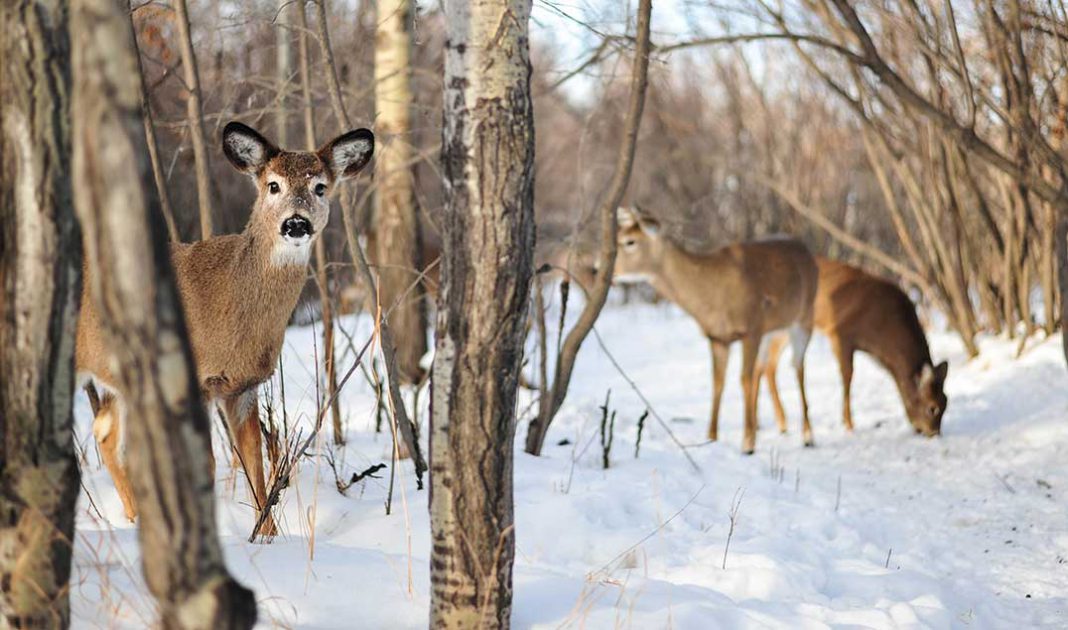KAGAWONG—With the severe winter that affected deer so much this year, the Manitoulin Deer Management Advisory Committee is recommending a significant reduction in antlerless deer tags for this fall’s annual deer hunt on the Island.
“I will be presenting harvest data from last fall’s hunt, but obviously winter severity is the big story this year,” stated Wayne Selinger, biologist with the Ministry of Natural Resources and Forestry (MNRF) at a meeting last week at the Park Centre in Kagawong. Mr. Selinger noted that the snow depth index for 2019 “was severe, with persistent cold and extreme snow depths, nasty crust conditions in March and a later-than-normal green-up. We saw at least a 30-year high for snow depths, close to 100 centimeters on the West End at one point,” said Mr. Selinger. “We are very lucky that the snow did not pile up earlier in the winter. But still it was a brutal winter and it had a real impact on the deer populations. Clearly, we lost significant numbers of deer this winter and we will see a very poor fawn crop this coming summer.”
“Two year classes would have been affected. Fawn losses this past winter would have been high, hence there will be fewer yearlings around this summer and fall and we will lose a good chunk of the 2019 fawn crop as well,” said Mr. Selinger. “I expect the population in WMU (Wildlife Management Unit) 43B will be down by 3,000 to 4,000 deer in fall 2019 as compared to fall 2018.”
Bill Orford agreed. “I would think we’re looking at a 25 percent loss. I found 25 dead deer on my property alone.”
Ian Anderson told the meeting that he and a few other members of the Gore Bay Fish and Game Club (GBFGC) had done an assessment on 75 acres of property west of Gore Bay close to Smith’s Bay. They found 17 deer carcasses on the ground. “We found jaws to get ages for many of them. Most were definitely fawns, although we did find one yearling buck and a few other adult deer. We checked the bone marrow in the femur of the back leg; most of them clearly starved but I expect a few were coyote kills.”
Mr. Selinger told the meeting, based on wolves and coyotes seen by hunters last fall, predator populations are relatively stable and moderate in WMU 43A, seemed to be ramping up in WMU 43B, but were not as high in 2018.
Mr. Anderson said, “the year after a bad winter you typically see larger animals and litter sizes. The coyotes I trapped towards the end of March were as fat as they were in October. I found 19 dead fawns on my trapline—none weighed over 40 pounds in mid-winter. And the coyotes were finding so much to eat, they would take one feed and not return to it because they could find another deer.” He suggested the population will double this summer.
Mr. Selinger provided information from the 2018 hunter survey and an analysis of deer populations in both WMUs including hunter success rates, harvest trends, deer seen per hunter day, tag allocations, etc.
“Hunter demand has decreased over time and is moderate in 43A. Deer populations in the unit declined over a 15- to 20-year period through to 2010, a habitat-related decline given reduced timber harvest. The population has been stable to increasing from 2010 to 2018. Tag allocations were increased from 300 in 1983 to 1,750 in 1989, then decreased to a low of 100 tags in 2014. We have been increasing tags since 2014; 500 were issued last year which made for a 65 percent draw success. As already discussed, winter 2019 was very severe and would have resulted in some direct mortality and a very poor 2019 fawn crop. Our goal is to maintain the deer population at the 2018 level,” said Mr. Selinger.
For WMU 43B, “deer density as of fall 2018 was on the high end of the scale provincially,” committee members were told. “We reintroduced additional seals in 2018 in an effort to reduce deer numbers. Hunting pressure and harvest are extremely high in 43B. Density decreased between 2003 and 2010 but has generally increased since 2010. The 2017 harvest was the highest since 2007 if the additional seal harvest from 2007 is excluded. The 2018 harvest excluding additional seals was down a bit from 2017. Tag allocations increased from 2,550 tags in 1982 to 6,000 between in 2000 and 2009. Allocations were reduced to 2,500 in 2014. Since 2015, tags have been increased in an effort to limit further population growth. In 2018, our goal was to decrease the population, targeting agricultural and municipal problem areas. Six thousand one-hundred regular antlerless tags and 1,000 additional seals were allocated. Of the 1,000 additional seals allocated, approximately 900 were purchased, resulting in an additional 450 antlerless deer harvested. Given the obvious impact of this past winter and increasing predator populations, our management goal has now changed to maintain or increase.”
“This is a no-brainer,” stated Mr. Selinger on his recommendation to reduce regular antlerless tags in 43A and 43B and eliminate the additional seals in 43B for this year. “At least until we can evaluate the full impact of this winter on next year’s harvest.”
“Given the winter we have had, I expect most agricultural problems will be resolved for the time being in most areas,” stated Mr. Selinger. “We should reduce antlerless tags in 43A and 43B and eliminate the additional seals until we can evaluate the full impact of this winter on next year’s harvest. If we monitor the harvest we can respond down the road when regular harvest in 43B significantly exceeds two deer per square kilometer. Other potential indicators of higher-than-desired density include hunter success (for any deer) consistently above 50 percent and deer seen per hunter day consistently above 1.4.”
“I expect the harvest to drop below two deer per square kilometer this fall. As it builds we can respond with increased tag allocations. One thing we will need to watch, hunter harvest data will come from mandatory reporting now so it might take a bit to see how the new data compares with the old,” said Mr. Selinger. “In theory, the data should be better but it could be different from the historic dataset that we have maintained.”
After this year’s severe winter, “it’s going to take deer three or four years to recuperate,” said John Seabrook.
Roy Polsky agreed, suggesting, “we should reduce tags by 2,000 or 3,000 at least for this year.”
“My gut feeling would be a 50 percent cut,” said Mr. Selinger.
Bruce Wood said, “I’m thinking the population will be down about 30 percent so I would be in favor of a 30 percent reduction in tags. In my area, the coyote population is escalating, so we don’t need additional tags right now, but we need to be ready when the population increases again.”
“People know it has been a hard winter on deer,” said Lee Hayden. “They are expecting tag reductions. I would think we had at least a 20 percent loss of deer this past winter. If we take one-third of the tags that would take us to 4,000 in WMU 43B.”
“Why not go with the 50 percent reduction,” suggested Mr. Seabrook.
“We could try it for a year. The fastest way to recover is to bite the bullet and go with a 50 percent tag reduction this year,” another member of the committee said.
Chris Robinson of the GBFGC said his club recommended at least a 30 percent tag reduction while Jack Ferguson said the Little Current Fish and Game Club was recommending a 25 percent reduction.
The recommendation that was made and supported by the meeting was to eliminate the additional seals for this year and go to 4,000 tags in 43B and to reduce from 500 to 300 tags in 43A.





